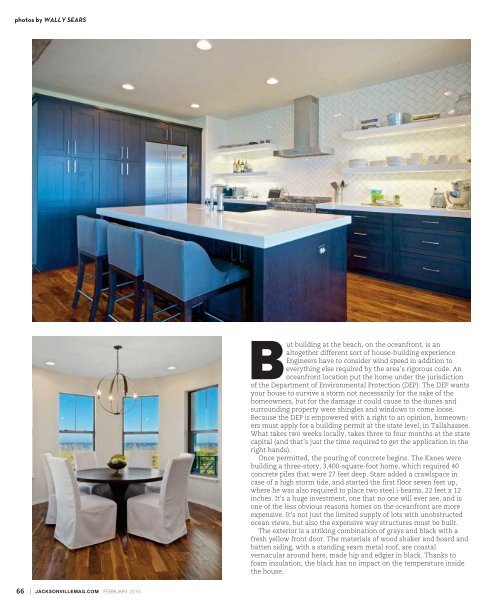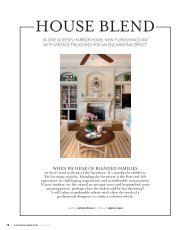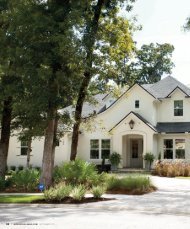Wild at Heart - Jax Magazine February 2015
My article was on a beach house in Jacksonville Beach, where the family lives year round. But the cover is so beautiful, I'm happy to use it here.
My article was on a beach house in Jacksonville Beach, where the family lives year round. But the cover is so beautiful, I'm happy to use it here.
Create successful ePaper yourself
Turn your PDF publications into a flip-book with our unique Google optimized e-Paper software.
photos by WALLY SEARS<br />
ut building <strong>at</strong> the beach, on the oceanfront, is an<br />
altogether different sort of house-building experience.<br />
Engineers have to consider wind speed in addition to<br />
everything else required by the area’s rigorous code. An<br />
oceanfront loc<strong>at</strong>ion put the home under the jurisdiction<br />
of the Department of Environmental Protection (DEP). The DEP wants<br />
your house to survive a storm not necessarily for the sake of the<br />
homeowners, but for the damage it could cause to the dunes and<br />
surrounding property were shingles and windows to come loose.<br />
Because the DEP is empowered with a right to an opinion, homeowners<br />
must apply for a building permit <strong>at</strong> the st<strong>at</strong>e level, in Tallahassee.<br />
Wh<strong>at</strong> takes two weeks locally, takes three to four months <strong>at</strong> the st<strong>at</strong>e<br />
capital (and th<strong>at</strong>’s just the time required to get the applic<strong>at</strong>ion in the<br />
right hands).<br />
Once permitted, the pouring of concrete begins. The Kanes were<br />
building a three-story, 3,400-square-foot home, which required 40<br />
concrete piles th<strong>at</strong> were 27 feet deep. Starr added a crawlspace in<br />
case of a high storm tide, and started the first floor seven feet up,<br />
where he was also required to place two steel i-beams, 22 feet x 12<br />
inches. It’s a huge investment, one th<strong>at</strong> no one will ever see, and is<br />
one of the less obvious reasons homes on the oceanfront are more<br />
expensive. It’s not just the limited supply of lots with unobstructed<br />
ocean views, but also the expensive way structures must be built.<br />
The exterior is a striking combin<strong>at</strong>ion of grays and black with a<br />
fresh yellow front door. The m<strong>at</strong>erials of wood shaker and board and<br />
b<strong>at</strong>ten siding, with a standing seam metal roof, are coastal<br />
vernacular around here, made hip and edgier in black. Thanks to<br />
foam insul<strong>at</strong>ion, the black has no impact on the temper<strong>at</strong>ure inside<br />
the house.<br />
66 | JACKSONVILLEMAG.COM FEBRUARY <strong>2015</strong>


















